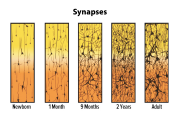The first few years of a child’s life are nothing short of miraculous. During this period, their brain grows faster than at any other time in life. By age two, a child’s brain is already 80% the size of an adult brain. This rapid development lays the foundation for all future learning, behavior, and health. Between 6 months and 2 years, key milestones such as language, emotional regulation, motor skills, and social interaction begin to take shape. But as technology becomes more embedded in daily life, concerns about screen time are becoming more relevant than ever.
So, what exactly happens in a child’s brain during this crucial window? And how does screen time influence that development?
Brain Development from 6 Months to 2 Years
1. Neural Connections Explode
From birth to age two, the brain creates more than 1 million new neural connections every second. This process, called synaptogenesis, peaks in the first two years of life. These connections are shaped by experiences—everything from a parent’s smile to the sound of music or the feel of a soft toy.

The image illustrates how rapidly synapses (the connections between neurons) develop from birth to adulthood:
At 6 months, a baby is learning through senses—touch, taste, sound, and sight. They recognize familiar voices, respond to their name, and start experimenting with cause and effect.
By 12 months, they’re picking up language cues, taking first steps, and showing preferences. Their brain is working overtime to link emotions, reactions, and outcomes.
By 24 months, toddlers are forming short sentences, following instructions, solving basic problems, and engaging in imaginative play. Their memory, reasoning, and emotional understanding are becoming more complex.
2. Language Development
Between 6 to 24 months, language centers in the brain are highly active. Babies move from cooing and babbling to saying their first words and, by two, may know over 50 words. This doesn’t just happen by magic—it’s the result of constant auditory input, face-to-face interaction, and responsive communication with caregivers.
3. Motor Skills and Coordination
Children go from lying on their backs to crawling, standing, walking, and even climbing. Fine motor skills (like picking up small objects or feeding themselves) also develop rapidly, as the brain maps coordination between muscles and intention.
4. Social and Emotional Learning
Children learn to recognize emotions in others, express their own feelings, and form attachments. They respond to affection, begin to understand
routines, and even start showing early empathy. Secure, responsive relationships help shape the brain’s stress regulation systems.
Screens
Now, imagine introducing a digital screen into this picture. In today’s digital age, screens are almost unavoidable. Smartphones, tablets, televisions, and even smart toys are common household items. While screens can be educational and entertaining, the timing, content, and duration of exposure matter a lot—especially during this delicate window of brain development.
What Research Says About Screen Time Before Age 2
The American Academy of Pediatrics (AAP) recommends no screen time (other than video chatting) for children under 18 months, and very limited high-quality programming for those between 18–24 months.
WHY? Because young children don’t learn well from screens. Their brains are wired to learn best from real, hands-on experiences and human interaction.
Here are some critical ways screen time can impact brain development;
1. Delays in Language Development
Increased screen time is associated with delays in expressive language. Unlike live conversation, screen viewing is passive. There’s no give-and-take, no emotional feedback, and no chance for a child to respond or ask questions.
Simple exchanges like naming objects or singing with your child are far more effective in stimulating language development.
2. Impaired Social Skills
Too much screen time means missed opportunities to observe and practice social behavior. Skills like eye contact, turn-taking, and empathy come from human interaction—not from watching cartoons.
3. Disrupted Sleep Patterns
Exposure to screens, especially before bedtime, can interfere with melatonin production, leading to poor sleep. Sleep is crucial for memory consolidation and emotional regulation.
4. Overstimulation and Attention Issues
Fast-moving, high-contrast visuals overstimulate the developing sensory system and can negatively impact attention and self-regulation later in life.
5. Reduced Physical Activity
Movement is essential for motor and cognitive growth. Screens encourage sitting still, depriving toddlers of valuable crawling, climbing, and exploring time.
What Children Really Need: Healthy Alternatives
Instead of screens, babies and toddlers benefit most from:
● Face-to-face interaction – Talking, singing, reading, and responding builds critical brain circuits.
● Unstructured play – Blocks, dolls, and pretend play encourage creativity and problem-solving.
● Exploration – Crawling, climbing, and sensory experiences shape coordination and spatial awareness.
● Stable routines and loving care – Responsive parenting fosters security and emotional health.
Screen Time Guidelines for Parents
While eliminating screens completely may not be realistic, balance is key. Here are a few tips:
● Co-view and talk about what you see on TV.
● Big NO to hand screen like phone/tab. TV is okay.
● Limit content to age-appropriate, slow-paced programs.
● Avoid screens before bed or during meals.
● Be a role model with your own device use.
● Prioritize play, conversation, and affection over digital interaction.
Final Thoughts
The brain’s architecture is built through rich, interactive experiences. Technology is here to stay—but it shouldn’t replace the human connection a young child needs most.
Between 6 months and 2 years, what children need more than anything is your voice, your attention, your smile, and your love. The screen can wait. Their brain can’t.

